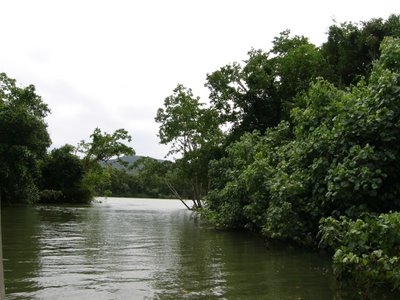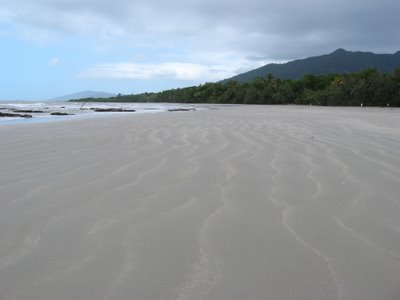Tropical North Queensland
This morning the alarm went off at 7AM and I woke up with the familiar feeling of summer. It was warm, humid, the fan was going, and I was excited to begin the day. It felt a bit like the first day of school or (and I know this makes me a complete geek, but we knew that already)the first day of band camp (as if fondly remembering the first day of school wasn't bad enough, geesh). Promptly at 7:55 I was picked up by Hans, tour guide for Tony's Tropical Tours and we stopped and picked up the UK family who's name I missed (two parents, three kids 10-14) and we were off. First we went to Mossman Gorge, a big deal here with the locals because it is a fresh water stream from the mountains, and although these mountains are not snowy peaks, the water is cool. This makes for great summer swimming when the temperature outside and the temperature in the ocean is 30 degrees C day and night. Pretty, but not really that special in my experience. (Well, besides the fact that it was in the rainforest, but you know what I mean. Your basic mountain stream.)
Promptly at 7:55 I was picked up by Hans, tour guide for Tony's Tropical Tours and we stopped and picked up the UK family who's name I missed (two parents, three kids 10-14) and we were off. First we went to Mossman Gorge, a big deal here with the locals because it is a fresh water stream from the mountains, and although these mountains are not snowy peaks, the water is cool. This makes for great summer swimming when the temperature outside and the temperature in the ocean is 30 degrees C day and night. Pretty, but not really that special in my experience. (Well, besides the fact that it was in the rainforest, but you know what I mean. Your basic mountain stream.)  After Mossman, we continued through sugar cane country to the Daintree River. That's a photo of a banana plantation by the way, find the big red flower and the bananas are just above it. Sugar cane looks just like corn without the corn, so I'll spare you that photo. If you've been through the middle US, you know what it looks like.
After Mossman, we continued through sugar cane country to the Daintree River. That's a photo of a banana plantation by the way, find the big red flower and the bananas are just above it. Sugar cane looks just like corn without the corn, so I'll spare you that photo. If you've been through the middle US, you know what it looks like. The Daintree River separates North Queensland into two bits. The populated, sugar producing southern section, and the barely populated, cattle farming northern section. (Oh yeah, there's no electricity in the northern section either. Everyone needs to have generators or solar power.) The Daintree Forest begins here as well.
The Daintree River separates North Queensland into two bits. The populated, sugar producing southern section, and the barely populated, cattle farming northern section. (Oh yeah, there's no electricity in the northern section either. Everyone needs to have generators or solar power.) The Daintree Forest begins here as well.  We took an hour's boat tour down the Daintree River and saw: a "baby" crocodile sunning himself on a branch near the water (and protecting himself from the other, larger, possibly hungry crocs), a tree snake about to shed his skin, a bat that eats the fruit from this specific tree and that is the only way the tree (and the bat) survive, two frog-somethingorother birds that look like owls, and a female adult croc. That's her sunning herself on the shore. The river is a mix of salt and fresh water and is heavily influenced by the tides. It is also lined with mangrove trees, which can handle the heavily salted water (by tree standards, anyway). The apples of the mangrove tree are toxic to most animals since it evolved in this area, and it depends on the fruit dropping into the salty water to disperse its seeds for reproduction.
We took an hour's boat tour down the Daintree River and saw: a "baby" crocodile sunning himself on a branch near the water (and protecting himself from the other, larger, possibly hungry crocs), a tree snake about to shed his skin, a bat that eats the fruit from this specific tree and that is the only way the tree (and the bat) survive, two frog-somethingorother birds that look like owls, and a female adult croc. That's her sunning herself on the shore. The river is a mix of salt and fresh water and is heavily influenced by the tides. It is also lined with mangrove trees, which can handle the heavily salted water (by tree standards, anyway). The apples of the mangrove tree are toxic to most animals since it evolved in this area, and it depends on the fruit dropping into the salty water to disperse its seeds for reproduction.  After crossing the river, we continued our trek to the north and to Cape Tribulation. Named by Captain James Cook, after he wrecked his boat on some reef in the area. He also named Mt. Despair and Mt. Sorrow, among others (I don't think he was too happy here, eh?).
After crossing the river, we continued our trek to the north and to Cape Tribulation. Named by Captain James Cook, after he wrecked his boat on some reef in the area. He also named Mt. Despair and Mt. Sorrow, among others (I don't think he was too happy here, eh?).
Things that make Cape Tribulation unique are:
- It's the end of the road. Literally. You need a 4x4 to get any further north, and you wouldn't really want to anyway. In Cape York, the furthest north you can get, the population density is 1 person to 100 square kilometers. (What happens if you need to borrow a cup of sugar?)
- Backpackers abound. That's not necessarily unique to Cape Tribulation, but it seems to be a haven for backpackers since there is only one resort here and it is quite posh. Everyone else has to camp, and nobody but a backpacker would put up with that.
- Coastal reef. The little dark bits just off the beach are the dead skeletons of coral reef that grows... on the coast. If you puddle hop to the end of it at low tide, you can see live reef growing on the ocean facing side. I didn't get to see that bit because a)it wasn't low tide, and b)the water was all murky from the sands all kicked up in the high winds these last few days.
After Cape Trib, it was lunch time and we descended upon a private picnic area, complete with swimming hole for lunch. I didn't go in, it was another freshwater stream and it was a tad chilly.
 After lunch, we headed south again to a hiking track through the bush. Here Hans regaled us of tales about the flora and fauna of the tropical rainforest and the Most Dangerous Plants I have ever seen. One of them has giant spikes and hooks like cactus, except there are no little grooves where you can touch it and not get pricked. It's completely covered. The needles are super strong as well, and they can cut you through to the bone if you were unlucky enough to take a flying leap into one. The good news is that once it reaches the canopy (and into the sunlight, thus no longer needing to fight its way up) it loses the spikes and becomes smooth rattan vines.
After lunch, we headed south again to a hiking track through the bush. Here Hans regaled us of tales about the flora and fauna of the tropical rainforest and the Most Dangerous Plants I have ever seen. One of them has giant spikes and hooks like cactus, except there are no little grooves where you can touch it and not get pricked. It's completely covered. The needles are super strong as well, and they can cut you through to the bone if you were unlucky enough to take a flying leap into one. The good news is that once it reaches the canopy (and into the sunlight, thus no longer needing to fight its way up) it loses the spikes and becomes smooth rattan vines. The other Most Dangerous Plant Ever is a bush with heart shaped leaves that bursts up out of areas where the canopy has been damaged and sunlight reaches the ground (ie. hiking trails and roads and anywhere recently effected by a cyclone like, oh, all of Queensland). This gawd awful shrub has microscopic silica-based needles that ironically make it look soft and fluffy but really sting you so bad you go into shock. After 4 days of excruciating pain, you can re-irritate the wound by applying cold water for up to a year. I spent the remaining hike with my hands in my pockets and wishing I'd worn long pants and socks, for god's sake, who doesn't hike with socks?!
After our hike, we went to a local ice cream "shop" and had ice cream made from various tropical fruits. I had mango (you know mangoes), sour sop (spiky, oval, green on the outside, and citrusy), golden wattle seed (golden wattle is the national flower of Australia, where they get the yellow and green national colors, and it tasted like mild coffee), and raspberry (that's not tropical, they can't fool me!). Trust me, they were small scoops.
Back into the Land Rover, onto the ferry, across the river, and back to Port Douglas. I'm beat.




1 comment:
Most Dangerous Plants Ever Seen? Yikes. This is something I don't need to see.
Post a Comment